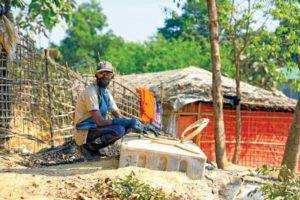Impact under spotlight in newly launched annual report
Practical Action has launched its new annual report, focusing on how the organisation achieves impact at scale through stories of change at multiple levels.
Over the next year, we will be sharing the best examples highlighted in the annual report, starting with an explanation of how we approach measuring change at an international level, and why it is important.
If you’d like to find out more, please check out our new annual report.
How we contribute to systems impact
The problems of climate change, poverty and environmental degradation exist because the core systems that underpin our world are failing. Changing these systems is beyond the capability of a single business, government, NGO (Non-Governmental Organisation) or individual. It needs people to work together, pooling their skills and resources on a global scale. Understanding this allows us to develop solutions that work for people at all levels of society, and for the living systems we rely on.
However, in a complex and interconnected world, achieving system change is not linear and happens at multiple levels over long periods of time. These changes may take years to achieve, and are brought about through the actions of many, including ourselves.
Everything we do at Practical Action is designed around the needs of the people we work with, and to contribute to changing the systems that hold them back. That’s why we work in varied and connected ways, to achieve impact:
 1. Sowing the seeds of change
1. Sowing the seeds of change
Developing community led solutions and evidence of what solutions work, and what doesn’t. And piloting new approaches to entrenched problems.
2. Cultivating strong growth
Building on practical success and lessons learned, with our partners, to create wider impact in communities at a national or regional level.
3. Reaping global harvests
Connecting key players from the private and public sectors with communities, so proven high-tech and low-tech solutions can contribute to sustained big change.
Reporting on our progress
Systems changes are challenging to measure. Especially when our work may contribute just one input to a much larger change, with multiple inputs over time. But as an organisation committed to big, systemic change, we believe it is important to measure and report on our progress as transparently as possible.
During the 2020-2021 reporting year we updated both how we measure our activities, and how we assess their outcomes.
Measuring our reach
We measure the reach of our activities annually, across different groups of people within a system. These groups may intersect and overlap, but this approach provides a measure of how many people we have reached with a potential benefit in a given year. Previously we have reported on direct and indirect reach. This year we have introduced an additional measure of systemic reach.
- Direct reach: Measures the number of people who benefit from participating directly in our projects and activities.
- Indirect reach: Measures the number of additional people who benefit beyond project participants. These are typically extended family members and the wider local community, as well as people reached through partners whom we have supported – such as local NGOs, or local government authorities.
- Systemic reach: Measures the wider groups of people reached by those equipped to deliver change at scale – such as the private sector and national governments. We measure systemic reach where we can demonstrate a clear causal link, and these numbers may vary significantly year on year. For example, our influencing work may contribute to a policy change that creates the enabling environment for large numbers of people to benefit in the future. Or our work with the private sector may result in changes to their business models that deliver rapid ongoing benefits to many people.
Demonstrating positive outcomes
As well as measuring the reach of our work, we’ve introduced new global indicators that report on resulting outcomes. These figures tell us about the positive effects recorded in the lives of communities we work with.
Our global indicators include the number of new jobs and businesses created; the number of changes made to the enabling environment that support our strategic aims; and how many of our projects are designed around specific gender needs.
In addition, we will report against a range of outcomes that relate to our core aims. For example this reporting could include the number and percentage of people with improved food security within a target area; or the number and percentage of people with better waste management systems within an identified slum community.
This is how we will measure progress towards our strategic objectives – from the positive changes to individuals’ lives through our projects, to our contribution to wider systemic change.
Meet the changemakers
We achieved this reach and impact by working with partners to take solutions from small and local to systemic and global. By convening the right mix of people at the right time, we were able to create meaningful change in many more lives than by acting alone.
Keep your eyes on the blog where we’ll continue to share stories that demonstrate the impact we’ve achieved in different contexts and at different scales. From a pilot project that’s set to overturn the status quo of urban migration in Kenya, to a partnership that’s already changed the game for millions in flood-prone areas around the world – and is set to do even more…
 1. Sowing the seeds of change
1. Sowing the seeds of change